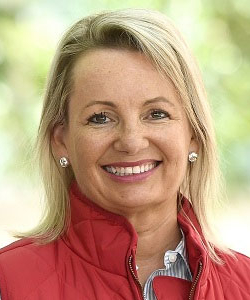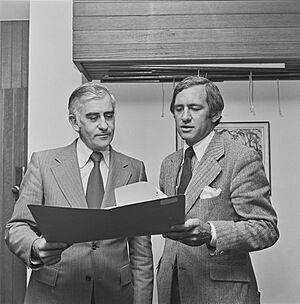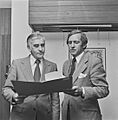Leader of the Opposition (Australia) facts for kids
Quick facts for kids Leader of the Opposition |
|
|---|---|

|
|

|
|
| Opposition of Australia Shadow Cabinet of Australia |
|
| Member of |
|
| Reports to | Parliament |
| Term length | While leader of the largest political party in the House of Representatives that is not in government |
| Inaugural holder | George Reid |
| Formation | 1901 |
| Salary | $390,000 |
In Australia's federal politics, the Leader of the Opposition is a special job. It's held by an elected member of parliament (MP) in the Australian House of Representatives. This person leads the main opposition party.
By tradition, the Leader of the Opposition is the head of the biggest political party in the House of Representatives that is not part of the government. When parliament meets, the opposition leader sits on the left side of the main table. They sit opposite the prime minister. The party chooses its leader based on its own rules. A new leader can be chosen if the old one leaves, resigns, or if someone challenges them for the role.
Australia is a constitutional monarchy. This means it has a King or Queen, but the country is run by elected officials. Australia's system is based on the Westminster system, which comes from the United Kingdom. In this system, the "opposition" has a clear role. The opposition's job is to question the government and try to show they could do a better job. They are often called the "government in waiting." They are loyal to the King or Queen, but they oppose the current government. This is why they are called "His Majesty's Loyal Opposition."
So far, Australia has had 36 opposition leaders. Nineteen of them later became prime minister. Since 13 May 2025, Sussan Ley has been the Leader of the Opposition. She is the first woman to hold this important role. The current Deputy Leader of the Opposition is Ted O'Brien. He was chosen as the deputy leader of the Liberal Party on the same day.
Contents
What Does the Leader of the Opposition Do?
The opposition leader is like the prime minister's main opponent. They are expected to be ready to form a new government. This usually happens if their party wins a federal election. Then, the opposition leader becomes the prime minister.
Sometimes, the opposition leader might form a government if the current government loses support. This happened in 1941 and 1975. The opposition leader also leads the shadow ministry. This is a group of politicians who act like they are in charge of different government departments. They watch what the real government is doing. The opposition leader also has a deputy leader. Both the leader and deputy leader get extra pay and special treatment in parliament.
The job of opposition leader is not written in Australia's Constitution. It exists because of long-standing tradition in the Westminster system. In 1960, a report about parliamentary salaries said:
The Leader of the Opposition has to make himself master of all the business which comes before the House (not merely that of one or two departments); he has to do this at times at short notice and under constant pressure; and he gets no help from permanent officials. At all times he is the spokesman for those who are critical of or opposed to the Government, and he must be unceasingly vigilant and active. He and the Prime Minister should be the most powerful agents in guiding and forming public opinion on issues of policy.
This means the opposition leader must know about all government matters. They must be ready to speak for those who disagree with the government. They help shape public opinion on important issues.
A Brief History of the Role
George Reid was the first unofficial Leader of the Opposition. This was before the first federal election in 1901. His role became official when the House of Representatives met for the first time. At first, the opposition leader did not get any extra salary. George Reid had to keep working as a lawyer to support himself. Because of this, he could only attend about one-third of the parliament's meetings.
The House of Representatives officially recognised the position in its records in 1920. That year, a law was passed that gave the opposition leader an extra allowance. Before this, Prime Minister Andrew Fisher offered Opposition Leader Alfred Deakin an allowance in 1910. Deakin said no to the money but did accept a paid secretary. In 1931, the role was added to the House's rules. This gave the opposition leader the right to speak for longer than other members in some cases.
How Much Does the Leader of the Opposition Earn?
The salary of the opposition leader is decided by an independent group called the Remuneration Tribunal. As of 1 July 2019, the leader gets a base salary of A$211,250. They also get an extra 85% on top of that. This means their total salary is around $390,000.
Images for kids
-
In the Australian House of Representatives, the Leader of the Opposition sits at the front table to the left of the Speaker's chair (on the right-hand side in this photo).
See also
 In Spanish: Líder de la oposición (Australia) para niños
In Spanish: Líder de la oposición (Australia) para niños
- List of prime ministers of Australia
- Politics of Australia





